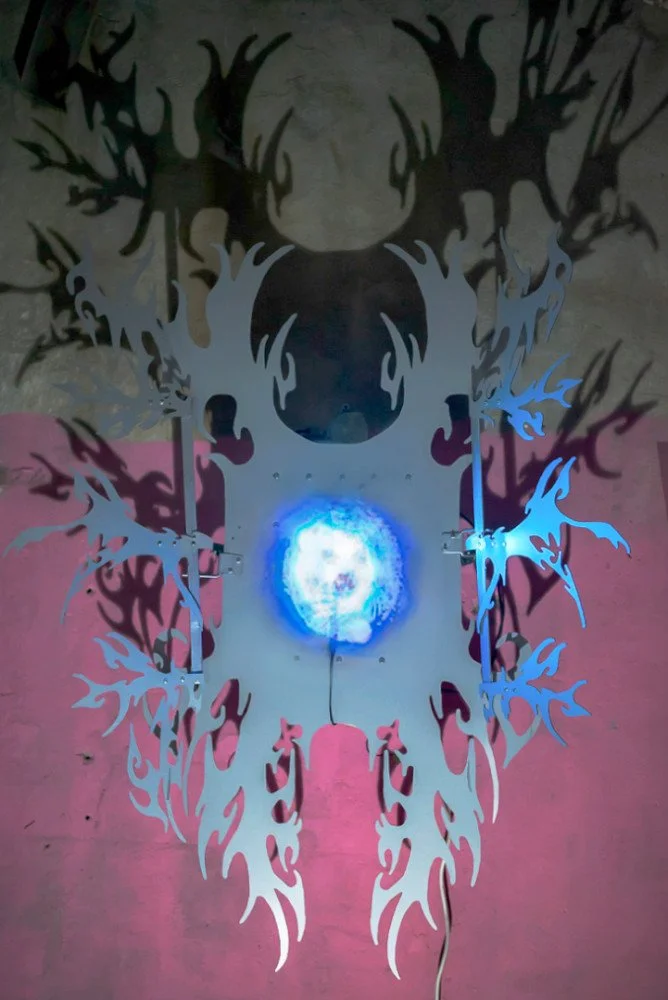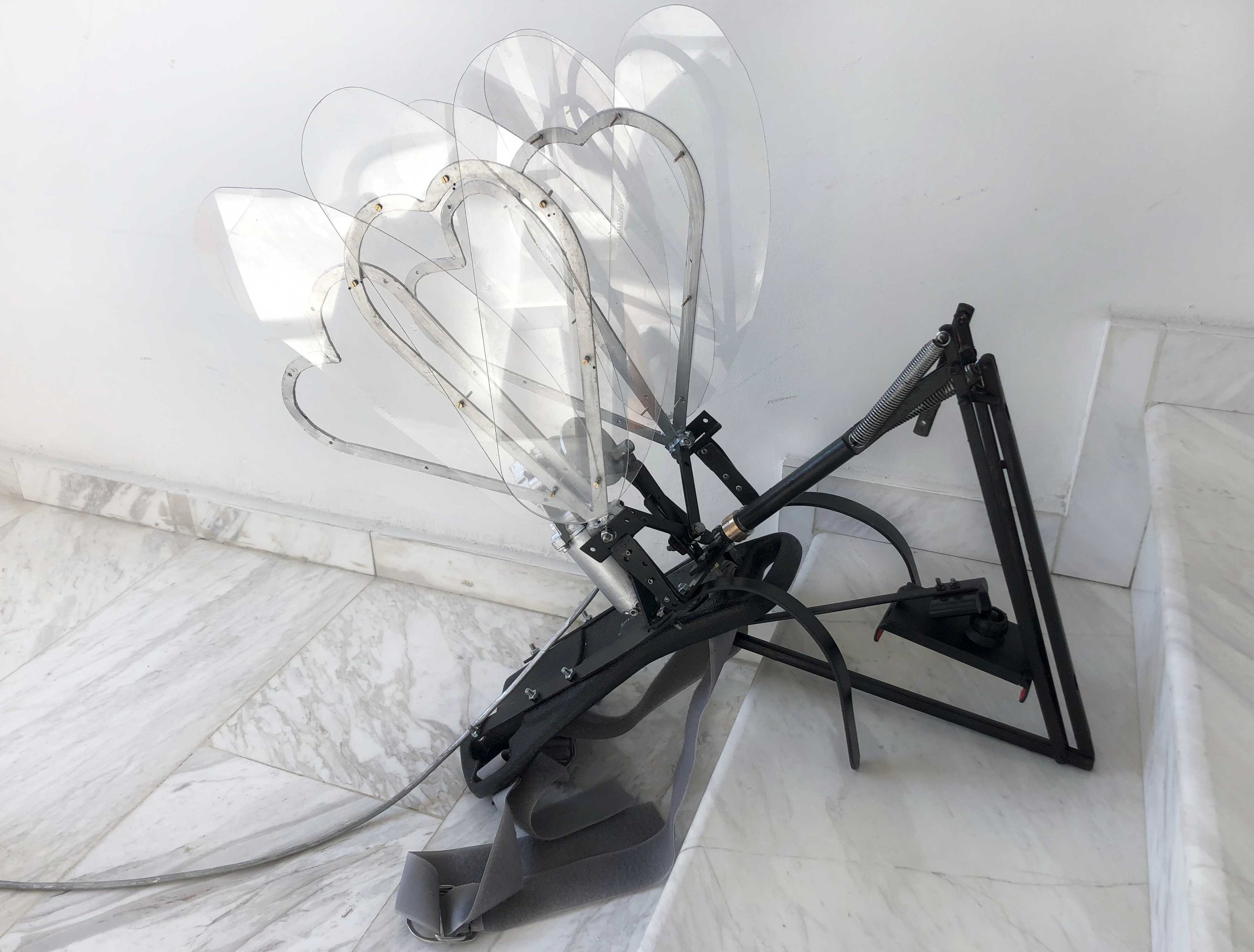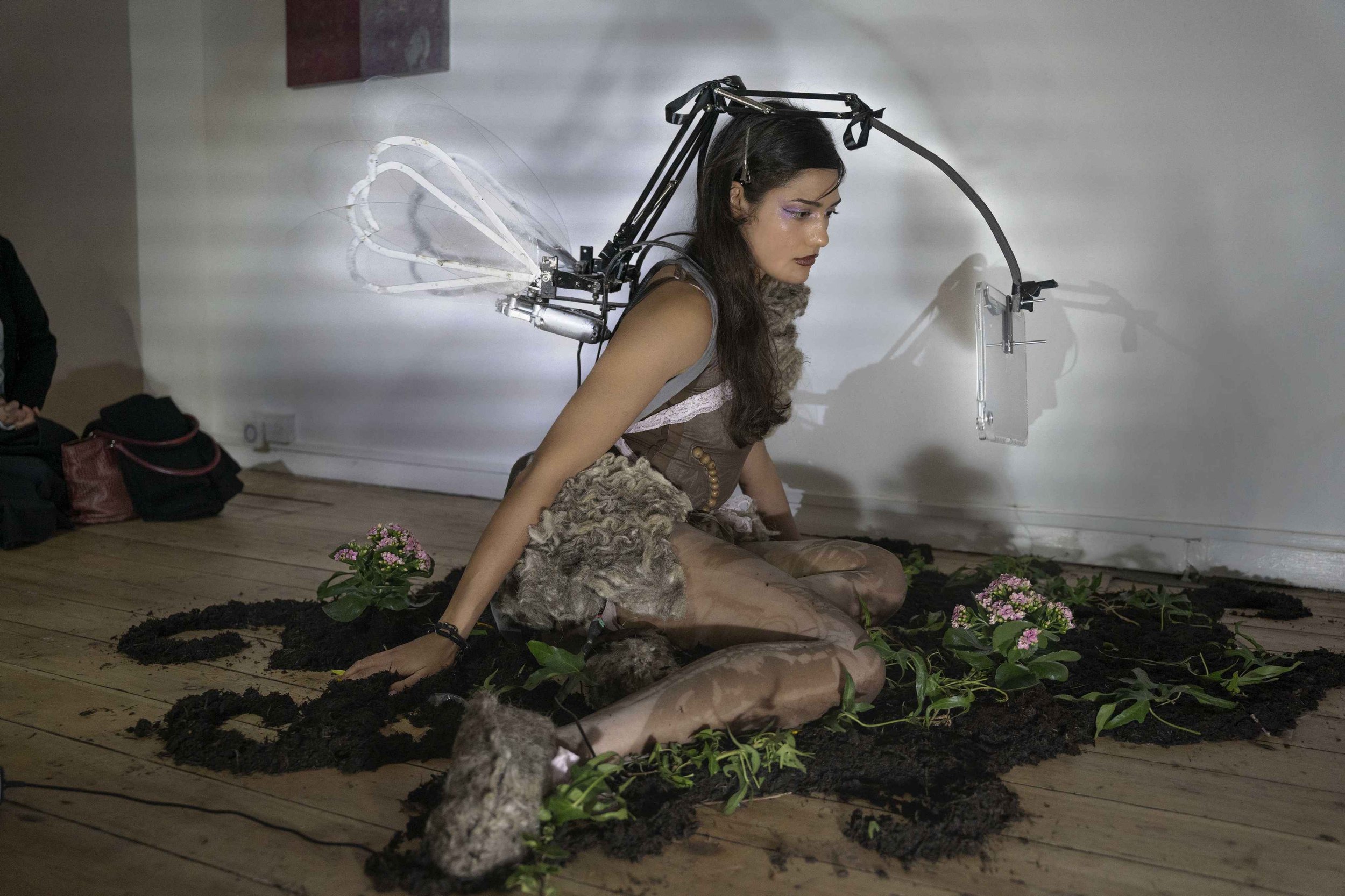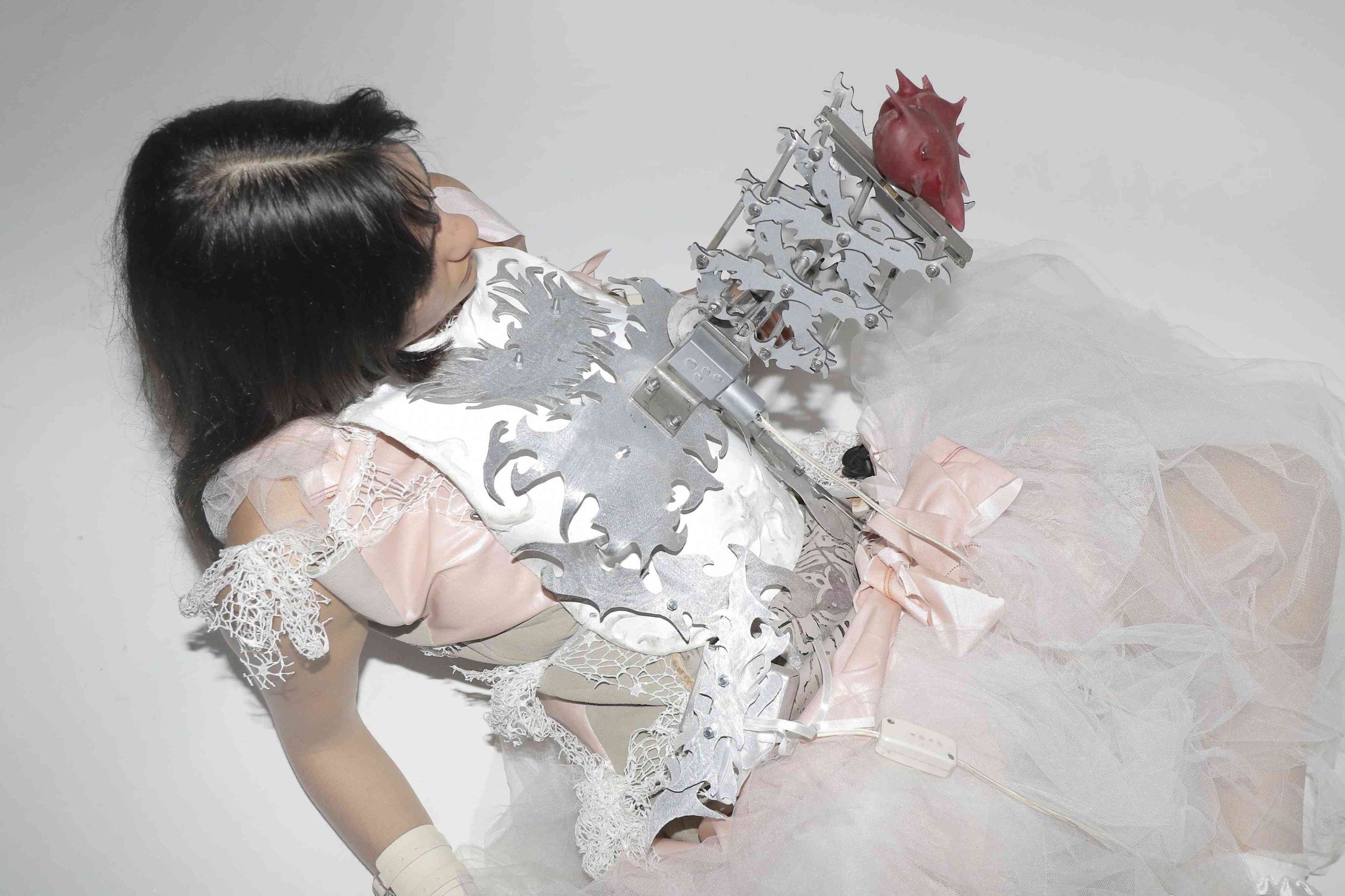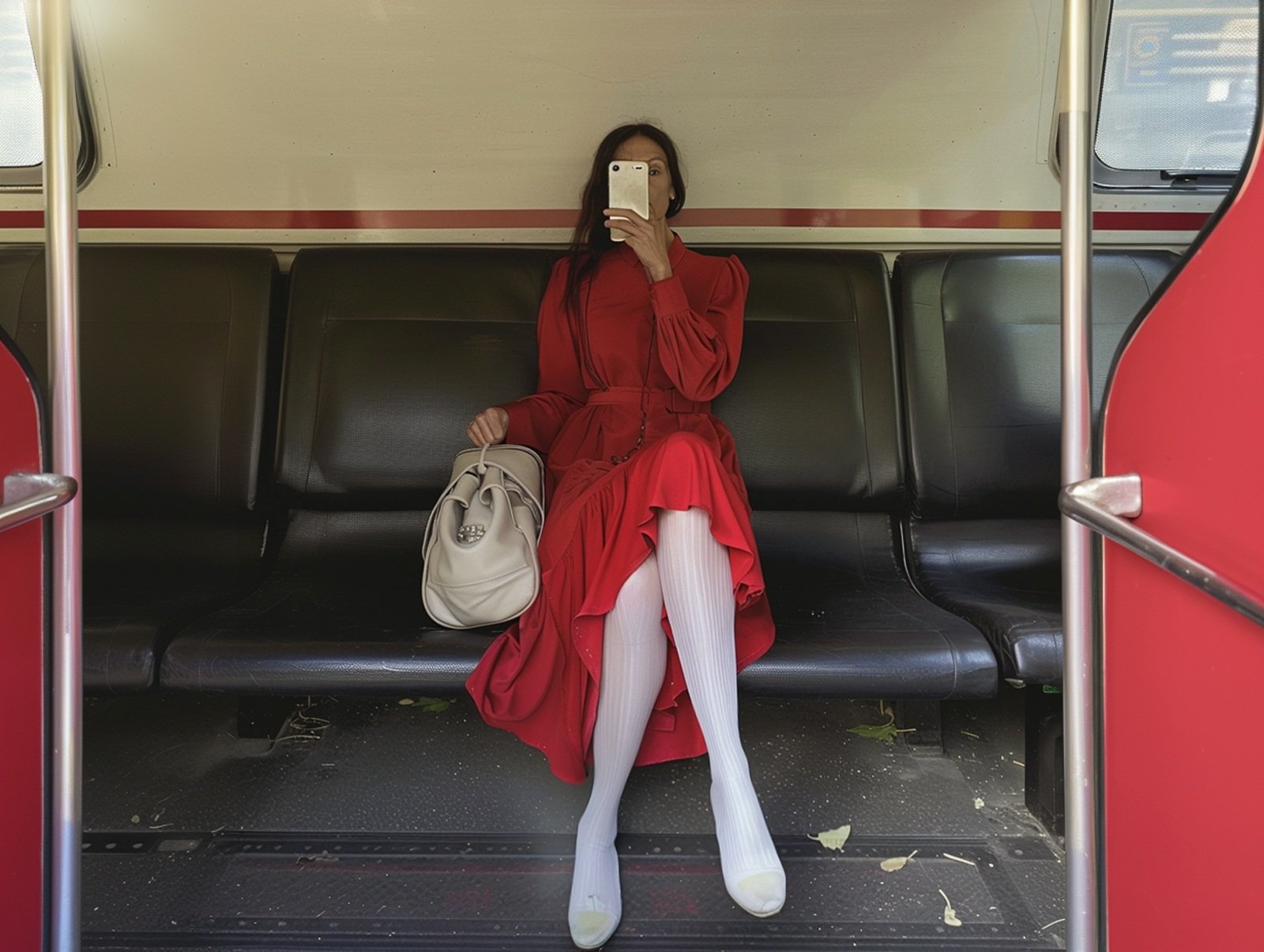Domenika Georgiou
Through her mechanical sculptures and cyber-prosthetics, Domenika explores the complex interplay between technology and human experience. Her work moves beyond the utilitarian to reflect on the nature of being in liminal spaces, where definitions blur and new possibilities emerge. She builds custom machinery that embodies this dynamic, creating objects that speak to the contradictions and complementarities shaping our understanding of existence. Deeply influenced by her grandfather’s mechanical workshop and her own studies in the arts, Domenika’s pieces are both reflective and innovative, pushing us to reconsider what lies at the core of identity and transformation.
Hello Domenika, we’re glad to have the chance to get to know you a bit more. How would you introduce yourself to our community?
I'm Domenika, I am an artist currently based in The Hague, working across various media to best serve my ideas and vision. Over the past few years, my focus has been building custom machinery—mechanical sculptures, wearable cyber-prostheses, and sonic apparatuses—integrated into immersive performances that fully engage the senses. Recently my focus has shifted back to music and I’m looking forward to integrating it further into these performances.
Could you tell us a bit about your background, where you are from, what did (or do) you study, and how you first got interested in sculpture, or even more specifically, in mechanical sculpture?
I’m from Cyprus and earned my Bachelor's in Painting at Brera Academy of Fine Arts in Milan. Currently, I'm pursuing a Master’s in ArtScience at The Royal Academy of Arts and Royal Conservatoire in The Hague.
My creative journey began with classical music training, in piano, violoncello, music theory and harmony. After high school I shifted from a scientific focus to fine arts.
During my second year of studying painting, I felt compelled to explore alternative modes of expression that resonated more with my experiences.
The pandemic brought me back to my hometown which provided me with the opportunity to reconnect with my childhood influences, particularly my grandfather’s mechanical workshop.
I realized how profound his impact was on me, influencing my interest in incorporating machinery into my artistic practice. This newfound direction felt instinctively right, leading me to experiment with machine-building and develop the necessary skills to realize my creative visions.
Looking back, my fascination with mechanics and metalwork began in childhood—crafting gifts from metal scraps, finely decorating them with delicacy and care, experimenting with electrical circuits, and creating noise instruments.
The very first machine sculpture you made was Perpetual Dream Machine, in 2021. It is about a wearable piece made of mechanical moving wings attached to a display showing a video animation. Can you tell us how you came up with the idea of this project?
The idea for the Perpetual Dream Machine was inspired by the concept of the perpetual motion machine–an unattainable idea as it cannot function indefinitely without an external energy source.
My grandfather often spoke about it, emphasizing its impossibility. This absurd concept—a Sisyphean fate of moving to no end—deeply intrigued me.
The idea that that progress paradoxically never truly reaches an endpoint, manifests the infinitude of life's dream and endless possibilities.
While developing the piece, I found myself being influenced by Douglas Hofstadter’s book Gödel, Escher, Bach, and his discussion on Strange loops, which involve self-reference and paradox.
I also drew inspiration from Zeno’s paradox of motion, an argument asserting the impossibility of motion since one must always traverse half the remaining distance ad infinitum.
This machine similarly appears to move eternally but never actually changes the position it occupies. It seems to progress towards the world of ideas—the Absolute—without ever arriving. It embodies a reflection on the perpetual pursuit of visions and the inherent futility of seeking an ultimate endpoint.
To create a mechanical object that reacts to an input and physically moves on its own doesn’t seem easy at all. Did you have any difficulty in the making process of this piece?
Working on the Perpetual Dream Machine, especially as my first attempt at creating a real machine, indeed felt like a Sisyphean, never-ending cycle of trial and error itself.
The mechanical wings and animation function separately yet conceptually co-depend, moving perpetually without reaching an end.
Built with old parts and motors, the process was quite challenging—having to design and craft each component on the lathe from scratch. Precision was crucial–even the smallest error demanded re-evaluation, re-design and adjustment.
““I view the act of creation as the highest form of Love.””
We recently saw your last project in Fabbrica del Vapore, which you told me at the exhibition that is still a work in progress. This time it was about a wearable mechanical object as well, able to read the heartbeat frequency. I find it very interesting the way you establish a dialogue between inanimate objects and human beings. What do you think of the technological progress we are achieving these days?
It is a prototype I'm currently developing further, which started during my residency in Milan with BJCEM. It is a wearable device that tracks the wearer’s heartbeat and translates it into changes in the surrounding environment through alterations in lighting and sound.
Today's technological developments certainly improve our lives, but also significantly threaten our society and ecosystems. Like this project suggests, its impact hinges on our intentions, which arise from our internal state and shape our external environment.
In this very last period, especially, one of the most debated themes is the use of Artificial Intelligence in the creative process to create art, generating conflicting opinions. What’s your thoughts about this? Do you believe in a utopian coexistence between Artificial Intelligence and the human being?
The use of AI in the creative process is not a new phenomenon—early AI art dates back to the 1960s. Indeed, its integration in the creative process has become so common today because most of the things that we interact with daily are powered by AI.
Our daily existence is permeated by algorithms, acting as invisible frameworks that control various systems and function as intuitive guides, shaping our reality.Whether passively or actively, it inevitably impacts the creative process.
I think that the most interesting use of AI in art lies in consciously using it to push its own boundaries, counteract its intended purpose and functionality, thereby challenging established algorithms.
Technology and humanity are deeply intertwined, revealing new meanings and shaping our experiences in ways beyond our control. To aim towards a harmonious coexistence, not just with ai but in general, we must engage critically, ensuring we are not compromising higher human values and apply it responsibly within a strong ethical framework.
The theme of contrast also returns in “Ghostly Swirls”, a sonic apparatus that connects with the sensible world in both harmonious and chaotic sound manifestations, performed in may 2023 at the noise event Facevalue in Cyprus. Could you explain to us your intention behind this work?
The idea for "Ghostly Swirls" emerged around the same time I was working on the Perpetual Dream Machine, a machine that cannot exist without an external force providing energy to bring it into existence. Contemplating the origin of existence, I thought about the prime energy of all nature—the absolute Prime Mover of all consciousness. An immortal and immutable entity that possesses supreme power instigating force in both harmonious and chaotic manifestations.
Each carillon spins in cycles symbolizing the nature of existence. The sound shifts from sweet, nostalgic melodies to cacophonic synthesis amplifying the forcefulness of a dreamlike somethingness emerging from nothingness.
Are you going to do other exhibitions soon? Where will we be able to see your art?
I certainly have some shows and residencies coming up–updates are always on my instagram. I can't wait to keep performing, build more machines, and further incorporate the musical aspect of my work into future shows. I’m always excited and open to exhibition collaborations, so there’s certainly more to come!
Interview by ALESSIA GJINI
What to read next


